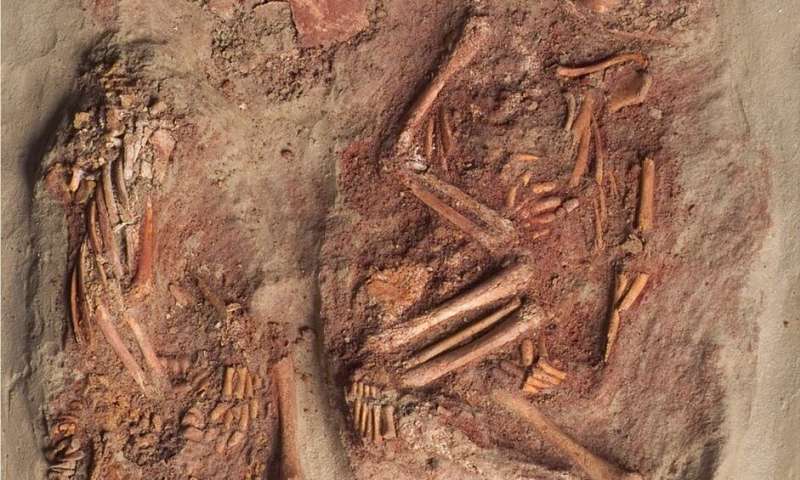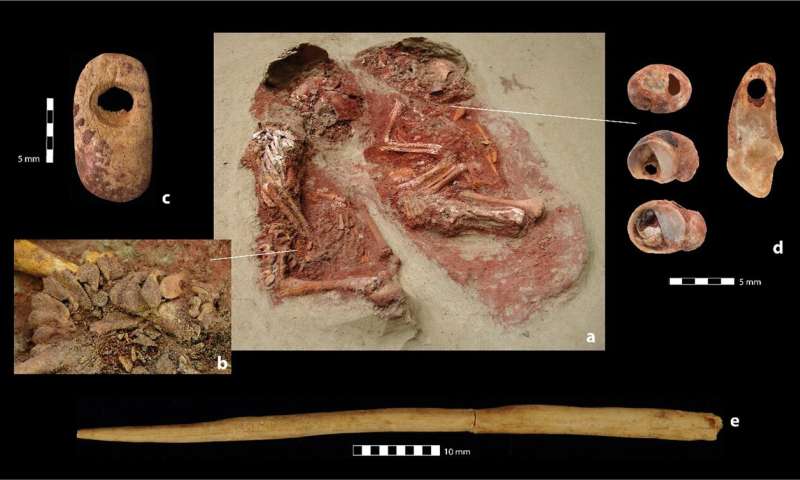by Bob Yirka , Phys.org

Burial 1 with the skeletal remains of two infants recovered as block in 2005 (ind1 on the left, ind2 on the right). Photograph: Natural History Museum Vienna; modified. Credit: Communications Biology (2020). DOI: 10.1038/s42003-020-01372-8
A team of researchers affiliated with multiple institutions in Austria, the U.S. and Portugal has identified the remains of two infants found in an ancient grave in Austria as identical twin babies. In their paper published in the journal Communications Biology, the group describes their study of the remains and the surrounding artifacts and what they learned about the burial.
Back in 2005, archeologists discovered the remains of three very young people buried in a grave at the Krems-Wachtberg, dig site in Austria—all three had been dated to approximately 30,000 years ago. Work at the site has revealed the presence of an ancient settlement called Gravettian. In this new effort, the researchers have studied the remains of the three infants and analyzed other artifacts found in the gravesite with them.
Two of the infants were buried under approximately five meters of soil. They were close to one another beneath a mammoth shoulder bone that had been cut and shaved to serve as a coffin lid. The lid had protected the remains, leaving them in very good condition. A DNA analysis showed that the two infants (both boys) were newly born identical twin babies. The first had died shortly after birth, while the second died approximately 50 days later. The time between deaths indicated that the gravesite had been reopened for use when the second baby died. The third infant, buried a small distance away and without a cover, was in poor condition, but the researchers were able to retrieve DNA material that showed it to be a cousin of the other two infants. The cause of the infants' deaths is unknown.
The grave itself was oval-shaped and the babies had been placed as if spooning—they had been laid on a bed of red ochre. The researchers also found 53 beads made of mammoth ivory lined up inside the grave, suggesting that they had been strung together. Because the beads showed no signs of wear, the researchers assumed they had been strung for the burial. The researchers also found three perforated mollusk shells in the grave and one fox incisor. The remains of the twins represent the oldest known monozygotic twins ever found.

A team of researchers affiliated with multiple institutions in Austria, the U.S. and Portugal has identified the remains of two infants found in an ancient grave in Austria as identical twin babies. In their paper published in the journal Communications Biology, the group describes their study of the remains and the surrounding artifacts and what they learned about the burial.
Back in 2005, archeologists discovered the remains of three very young people buried in a grave at the Krems-Wachtberg, dig site in Austria—all three had been dated to approximately 30,000 years ago. Work at the site has revealed the presence of an ancient settlement called Gravettian. In this new effort, the researchers have studied the remains of the three infants and analyzed other artifacts found in the gravesite with them.
Two of the infants were buried under approximately five meters of soil. They were close to one another beneath a mammoth shoulder bone that had been cut and shaved to serve as a coffin lid. The lid had protected the remains, leaving them in very good condition. A DNA analysis showed that the two infants (both boys) were newly born identical twin babies. The first had died shortly after birth, while the second died approximately 50 days later. The time between deaths indicated that the gravesite had been reopened for use when the second baby died. The third infant, buried a small distance away and without a cover, was in poor condition, but the researchers were able to retrieve DNA material that showed it to be a cousin of the other two infants. The cause of the infants' deaths is unknown.
The grave itself was oval-shaped and the babies had been placed as if spooning—they had been laid on a bed of red ochre. The researchers also found 53 beads made of mammoth ivory lined up inside the grave, suggesting that they had been strung together. Because the beads showed no signs of wear, the researchers assumed they had been strung for the burial. The researchers also found three perforated mollusk shells in the grave and one fox incisor. The remains of the twins represent the oldest known monozygotic twins ever found.

a The twin’s bodies (individual 1 and 2) in the grave pit of Burial 1. b, c Mammoth ivory beads and their arrangement on individual 1’s pelvis. d Adornment of Individual 2 consisting of a perforated fox incisor (Vulpes sp.) and three perforated molluscs (Theodoxus sp.). e Ivory pin from Burial 2 (individual 3) (find numbers: c Ivory bead WA-18158; d molluscs (from top to bottom) WA-151565, WA-151561, WA-151564, fox incisor WA-151558; e ivory pin WA-37552). Photographs: OREA, Austrian Academy of Sciences. Graph: R. Thomas. Credit: Communications Biology (2020). DOI: 10.1038/s42003-020-01372-8
Explore further Remains dug from Japan mass grave suggest epidemic in 1800s
More information: Maria Teschler-Nicola et al. Ancient DNA reveals monozygotic newborn twins from the Upper Palaeolithic, Communications Biology (2020).
Explore further Remains dug from Japan mass grave suggest epidemic in 1800s
More information: Maria Teschler-Nicola et al. Ancient DNA reveals monozygotic newborn twins from the Upper Palaeolithic, Communications Biology (2020).
DOI: 10.1038/s42003-020-01372-8
Journal information: Communications Biology
© 2020 Science X Network
Journal information: Communications Biology
© 2020 Science X Network
No comments:
Post a Comment